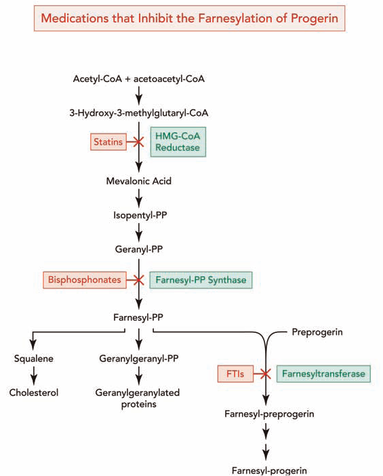Currently there is no cure for Progeria. Only the symptoms can be treated. The Progeria Research Foundation published a handbook for families and doctors for suggestions on treatments. This handbook was published in April 2010. Among the things this 100 page handbook discusses are the treatments that are currently being studied.
Before reading this first read WHAT CAUSES PROGERIA? to fully understand how the drugs will work. Or here is a quick summary:
Progeria is caused by a protein named progerin. A farnesyl group must be attached to the progerin protein in order to damage the cells and block normal cell functions therefore causing accelerating aging symptoms.
3 drugs currently being studied in treatment trials for Progeria:
1)Lonafarnib ( Farnesyltransferase Inhibitor (FTI) )
2) A statin called Pravastatin
3) A bisphosphonate called Zoledronic Acid
Before reading this first read WHAT CAUSES PROGERIA? to fully understand how the drugs will work. Or here is a quick summary:
Progeria is caused by a protein named progerin. A farnesyl group must be attached to the progerin protein in order to damage the cells and block normal cell functions therefore causing accelerating aging symptoms.
3 drugs currently being studied in treatment trials for Progeria:
1)Lonafarnib ( Farnesyltransferase Inhibitor (FTI) )
2) A statin called Pravastatin
3) A bisphosphonate called Zoledronic Acid
Lonafarnib
This drug is a farnesyltransferase inhibitor (FTI). FTI’s are a class of drugs that inhibit an enzyme that is necessary to attach to the farnesyl group to the progerin protein. If the farnesyl group can not be attached then the progerin protein can not fully function because in order to damage the cells and cause accelerated aging the progerin protein needs to be farnesylated. More on this experiment in Study 2.
Pravastatin
This drug is commonly used to lower cholesterol and prevent heart diseases. This drug is being used for children with Progeria since it also has an effect on blocking the production of the farnesyl molecule that is needed for progerin to cause accelerated aging. This drug was approved by the FDA in 2006 and according to them it should be taken once a day.
Zoledronic Acid
This drug is used to improve bone density in women with osteoporosis, and to prevent skeletal fractures in people suffering from some forms of cancer. It has also been used in children with a bone disease called osteogenesis imperfecta, and for other bone problems. Since a characteristic of children with Progeria is low bone density it is believed that over time this drug will help improve bone density. In addition, this drug has an effect on blocking the production of the farnesyl molecule that is needed for progerin to cause accelerated aging in children with Progeria. The FDA approved it in 2001, and according to them it should be administered intravenously several times per year.
Conclusion of the 3 drugs:
All of the drugs discussed affect the progerin protein in order to prevent it from affecting the cells of Progerian patients. They all essentially affect the process in which the cell makes the farnesyl group and attaches it to the progerin protein. REMEMBER: If the farnesyl group is not attached to the progerin protein than it will not be able to damage the cell therefore because the cells are not damaged the process of accelerated aging will not occur.
All of the drugs discussed affect the progerin protein in order to prevent it from affecting the cells of Progerian patients. They all essentially affect the process in which the cell makes the farnesyl group and attaches it to the progerin protein. REMEMBER: If the farnesyl group is not attached to the progerin protein than it will not be able to damage the cell therefore because the cells are not damaged the process of accelerated aging will not occur.

